Geo-Spatial Optimization and First and Last Mile Accessibility for Sustainable Urban Mobility in Bangkok, Thailand
Abstract
1. Introduction
1.1. Urban Mobility Challenges in Bangkok
1.2. First and Last Mile (FLM) as a Barrier to Mode Shift
1.3. Role of Spatial Integration and Digital Transport Services
1.4. Research Gaps and Objectives
2. Materials and Methods
2.1. Study Area Description
2.2. Behavioral and Travel Context (Secondary Descriptive Profile)
2.3. Geographic Information Systems (GIS) Analysis
2.3.1. Geo-Database Creation
2.3.2. Network and Location-Allocation Modeling
2.3.3. Isochrone-Based Accessibility Diagnostics and Multimodal Overlay
3. Results
3.1. Road Intersection Density (Network Analysis)
3.2. Hub Scenario Modeling (1, 3, and 5 Hubs)
3.2.1. Service Radii and Travel Time
3.2.2. Integration with Existing Lines
3.3. FLM Behavior
4. Discussion
4.1. Interpretation of Hub Scenario Effectiveness
4.2. Strategic Role of GIS in Mega-Urban Contexts
4.3. Role of Intra-Household Travel Decision-Making
4.4. MaaS and Co-Sharing: Readiness and Design
4.5. Policy Implications and Study Limitations
4.5.1. Policy Implications
4.5.2. Study Limitations and Scope
5. Conclusions
Author Contributions
Funding
Institutional Review Board Statement
Informed Consent Statement
Data Availability Statement
Acknowledgments
Conflicts of Interest
Appendix A
| Scenario | Covered Units | Not Covered Units | Covered Population |
|---|---|---|---|
| One hub, 15 min | 11 | 39 | 614,128 |
| One hub, 25 min | 21 | 29 | 1,521,868 |
| Three hubs, 15 min | 19 | 31 | 1,377,339 |
| Three hubs, 25 min | 35 | 15 | 3,400,177 |
| Five hubs, 15 min | 24 | 26 | 1,883,268 |
| Five hubs, 25 min | 41 | 9 | 4,134,771 |
| Configurations | Units | Catchments |
|---|---|---|
| One hub, 15 min | Pathum Wan | 614,128 (11 units) |
| One hub, 25 min | Pathum Wan | 1,521,868 (21 units) |
| Three hubs, 15 min | Thon Buri | 528,411 (6 units) |
| Pathum Wan | 468,686 (9 units) | |
| Suanluang | 380,242 (4 units) | |
| Three hubs, 25 min | Thon Buri | 1,421,661 (17 units) |
| Huai Khwang | 1,136,011 (12 units) | |
| Bang Khen | 842,505 (6 units) | |
| Five hubs, 15 min | Thon Buri | 528,411 (6 units) |
| Suanluang | 380,242 (4 units) | |
| Bang Sue | 350,783 (4 units) | |
| Pathum Wan | 324,809 (7 units) | |
| Huai Khwang | 299,023 (3 units) | |
| Five hubs, 25 min | Thon Buri | 1,060,707 (15 units) |
| Suanluang | 895,348 (8 units) | |
| Bang Khen | 842,505 (6 units) | |
| Bang Sue | 765,399 (8 units) | |
| Bang Khae | 570,812 (4 units) |
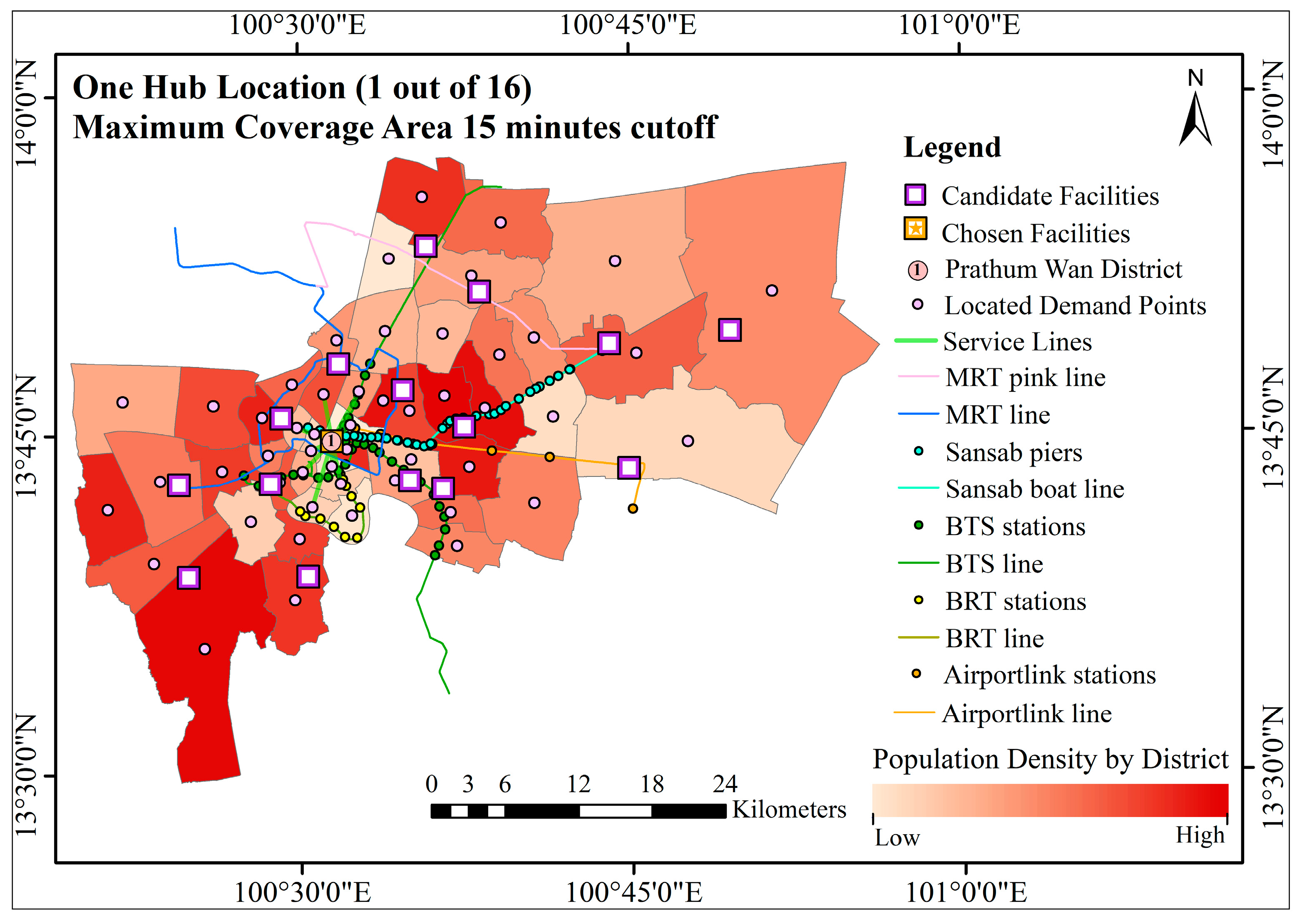

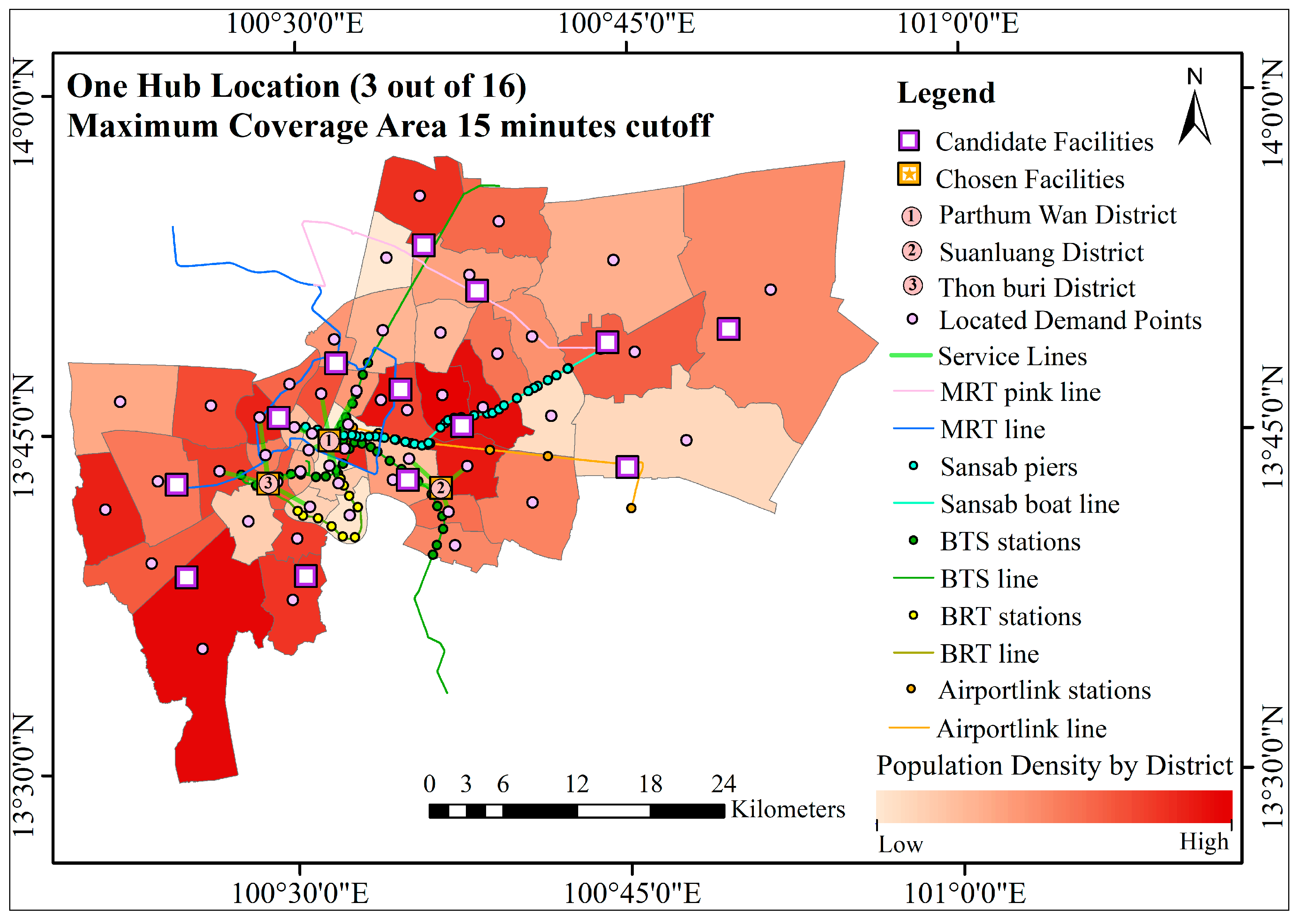
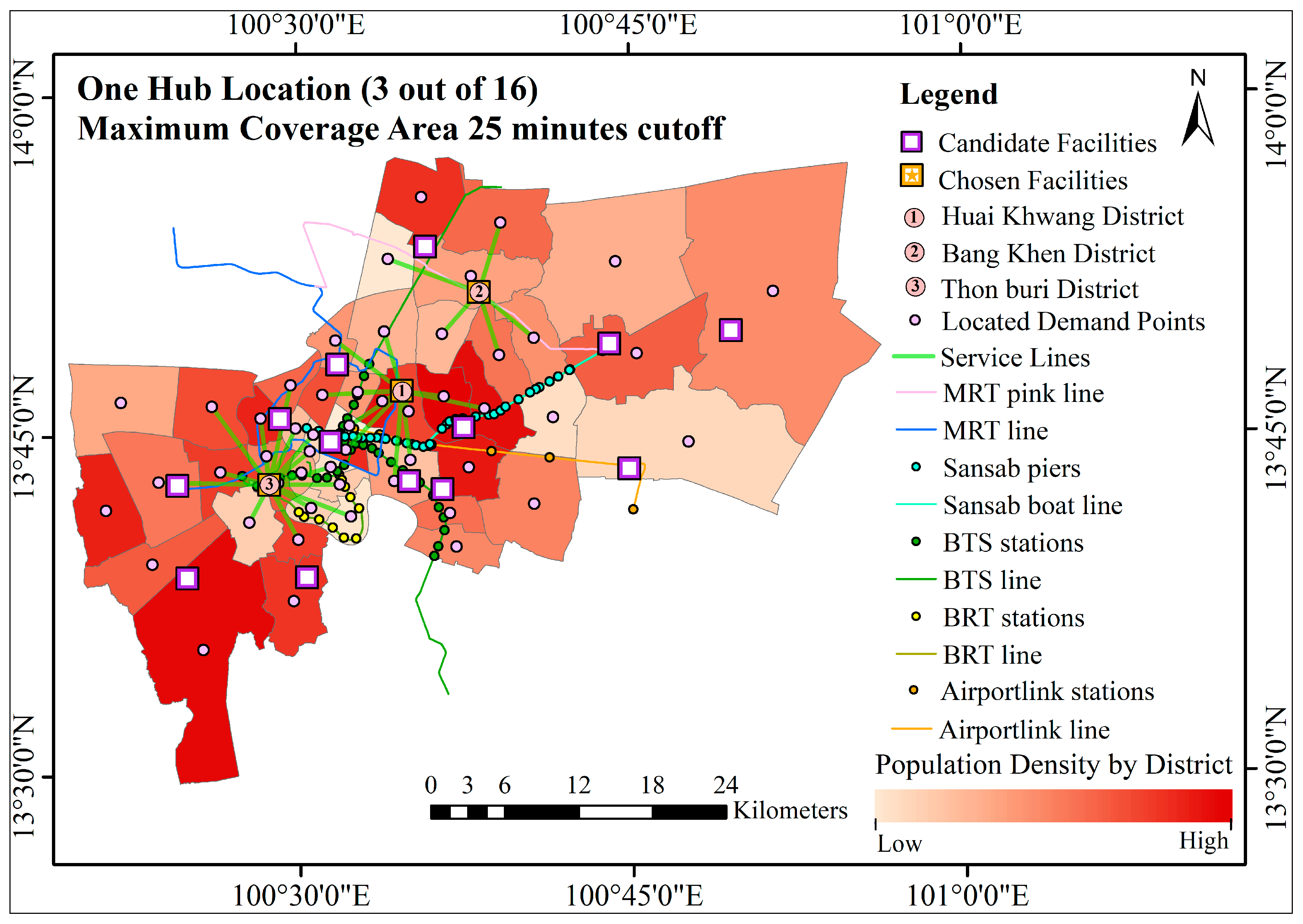
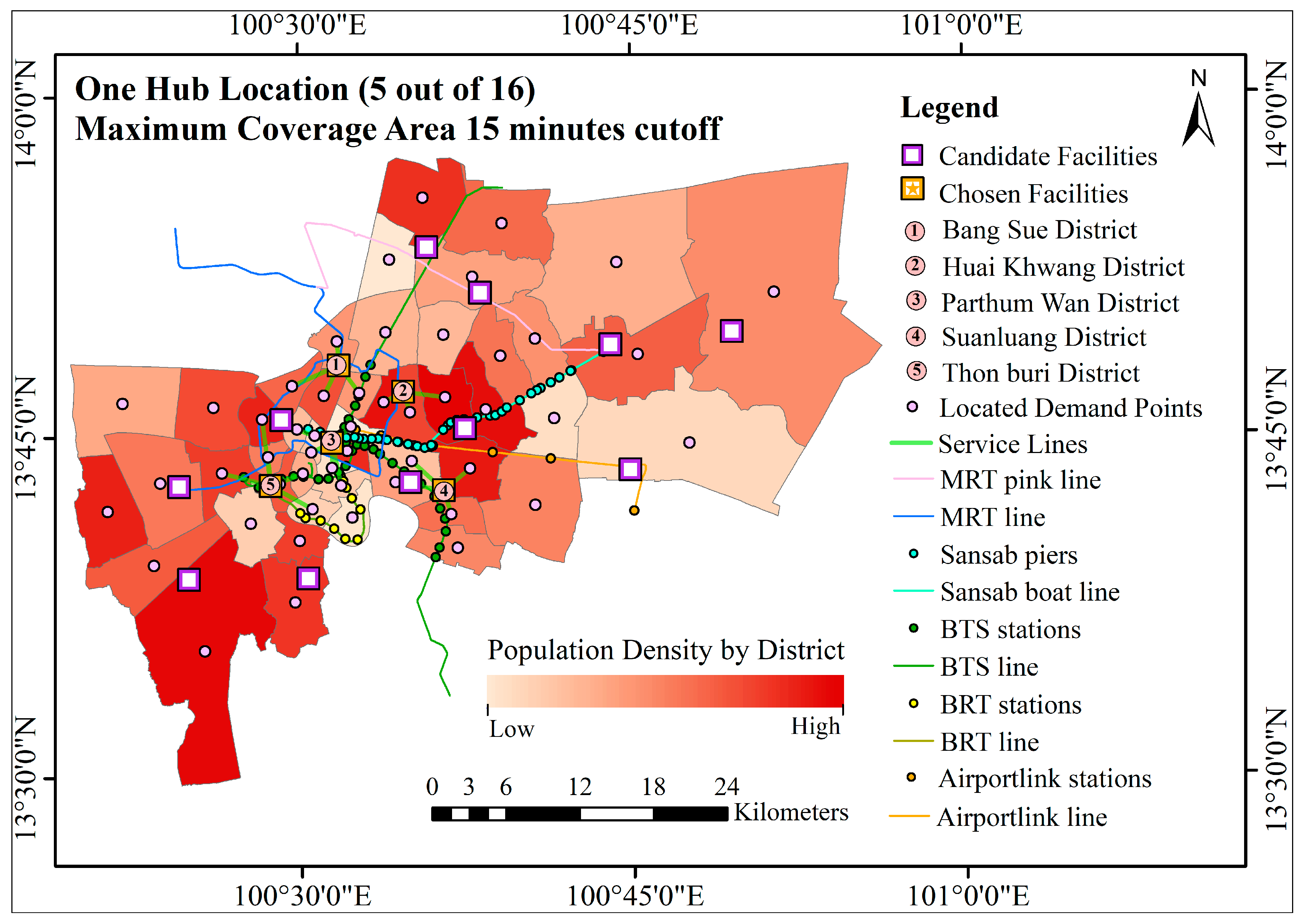
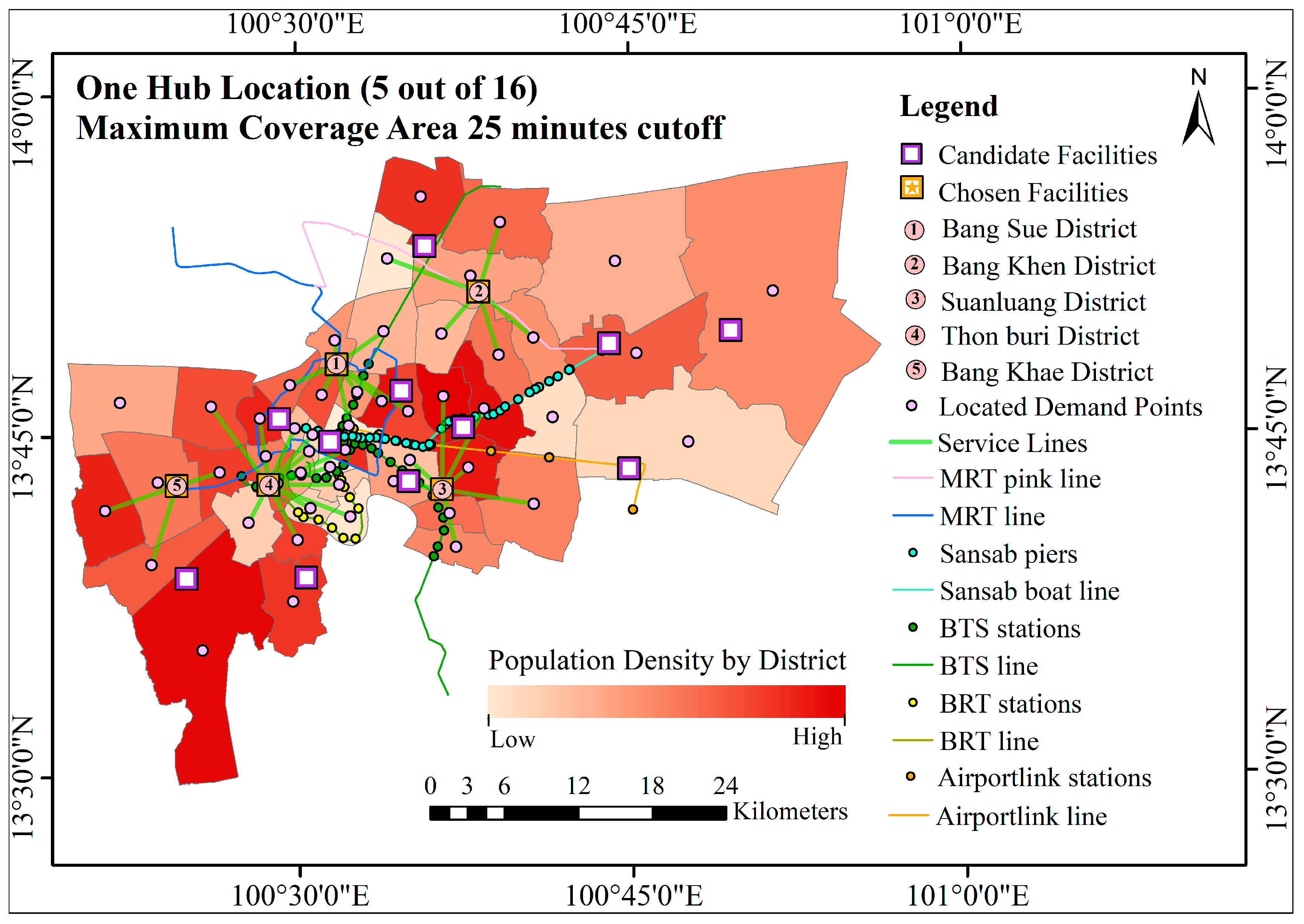
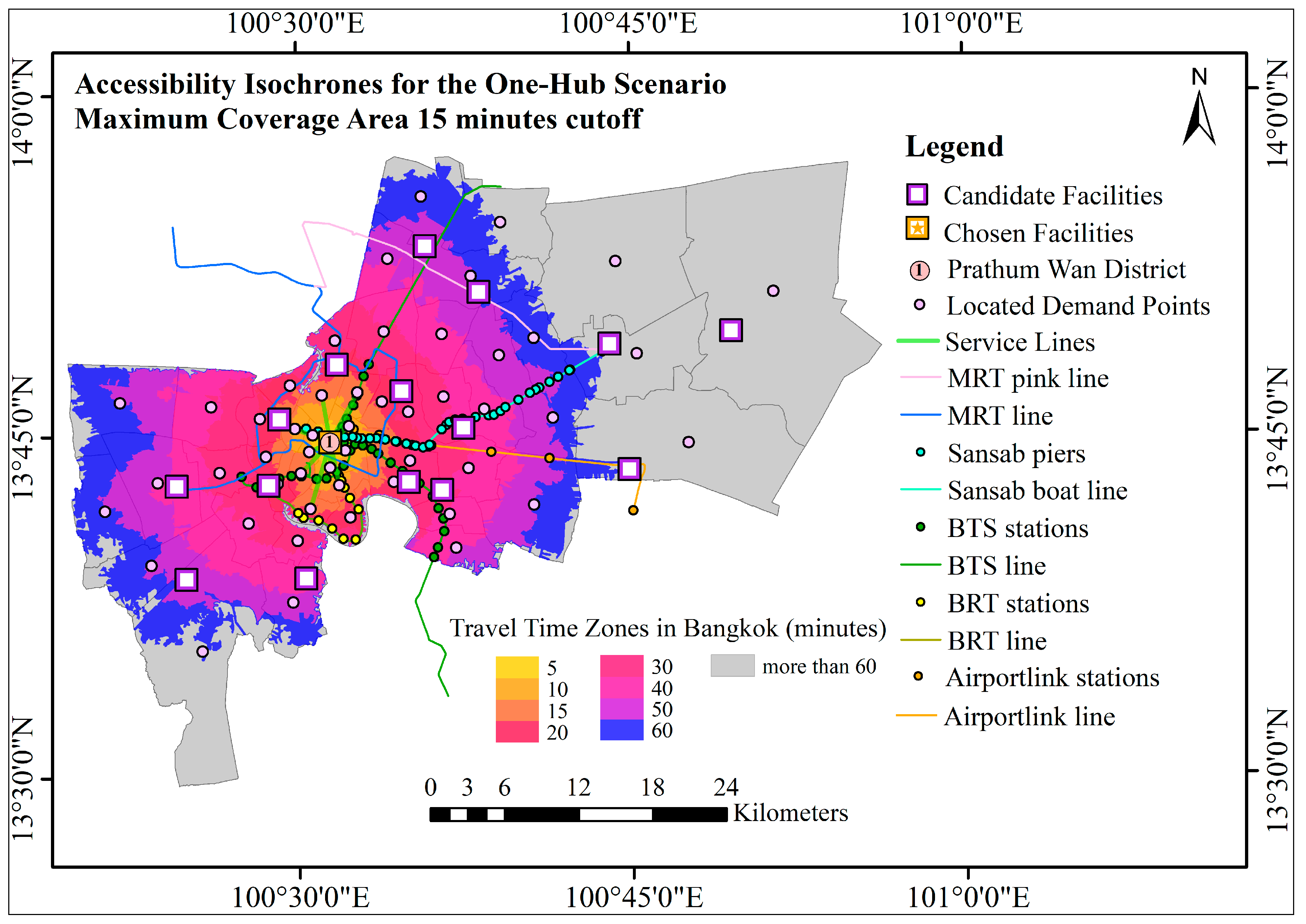
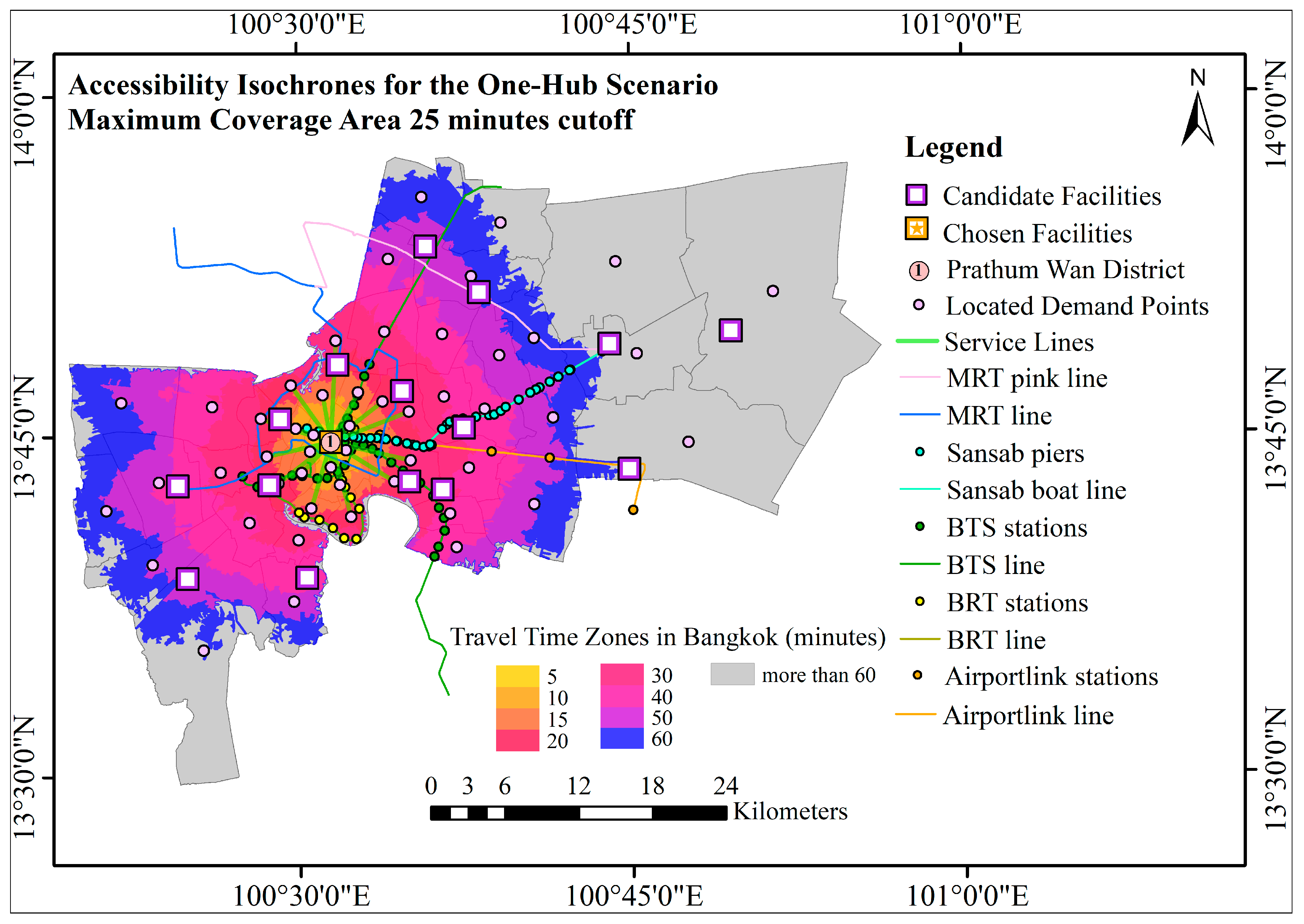

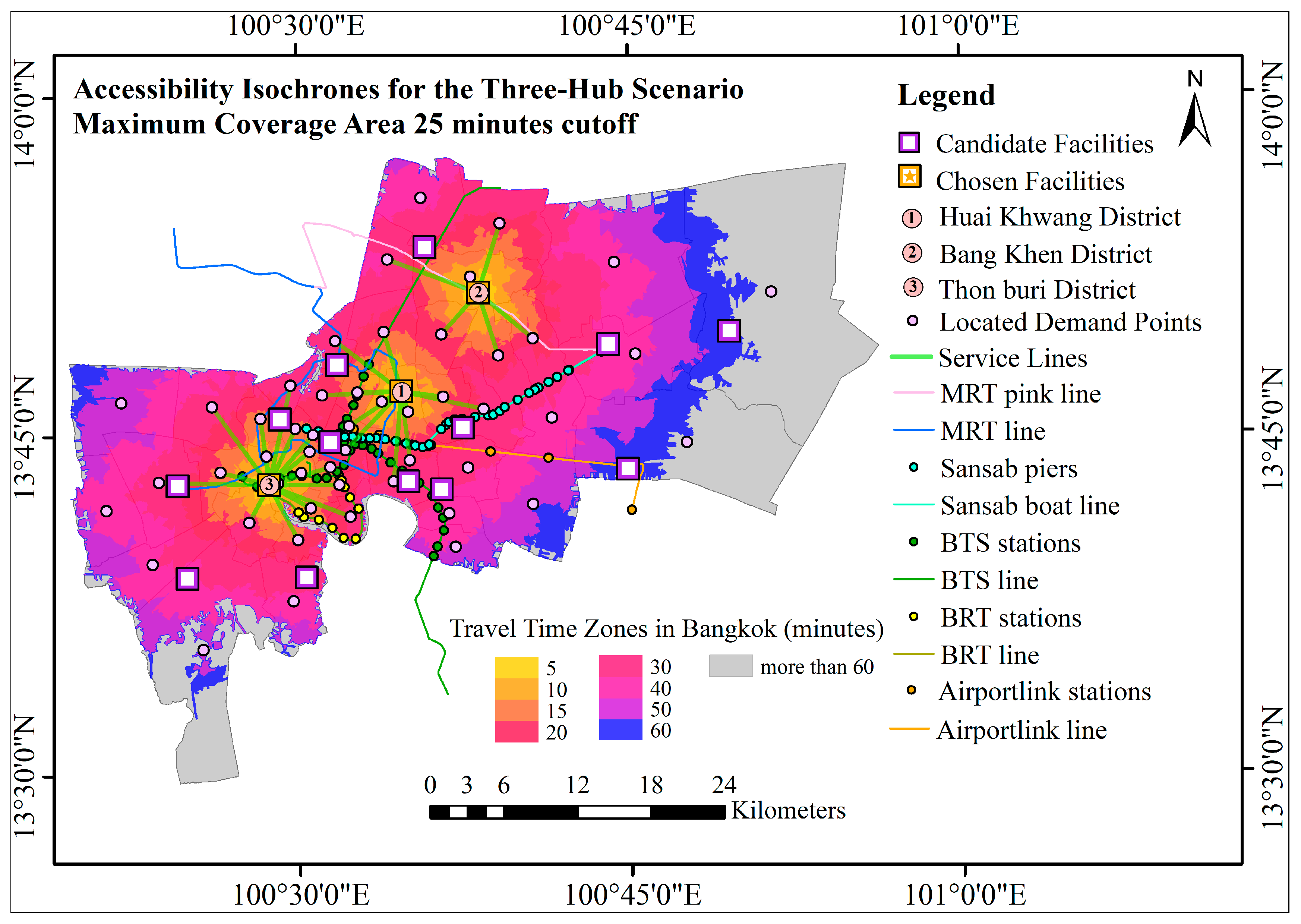
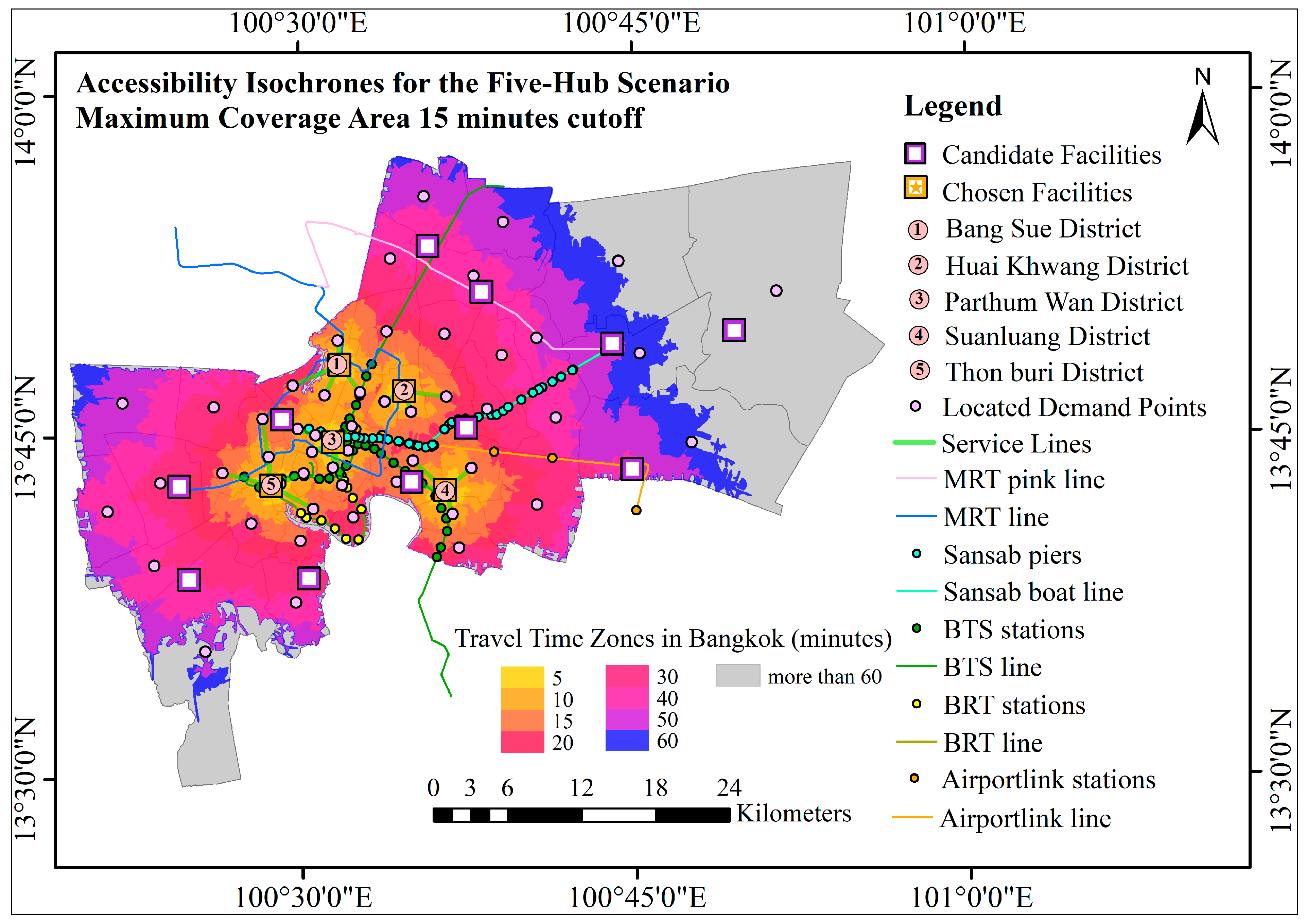

References
- Losiri, C.; Nagai, M.; Ninsawat, S.; Shrestha, R.P. Modeling Urban Expansion in Bangkok Metropolitan Region Using Demographic-Economic Data through Cellular Automa-ta-Markov Chain and Multi-Layer Perceptron-Markov Chain Models. Sustainability 2016, 8, 686. [Google Scholar] [CrossRef]
- Ayaragarnchanakul, E.; Creutzig, F.; Javaid, A.; Puttanapong, N. Choosing a Mode in Bangkok: Room for Shared Mobility? Sustainability 2022, 14, 9127. [Google Scholar] [CrossRef]
- Fold, N.R.; Allison, M.R.; Wood, B.C.; Thao, P.T.B.; Bonnet, S.; Garivait, S.; Kamens, R.; Pengjan, S. An Assessment of Annual Mortality Attributable to Ambient PM2.5 in Bangkok, Thailand. Int. J. Environ. Res. Public Health 2020, 17, 7298. [Google Scholar] [CrossRef]
- Chalermpong, S.; Ratanawaraha, A.; Anuchitchanchai, O. Motorcycle Taxis’ Varying Degrees of Complementarity and Substitution with Public Transit in Bangkok. J. Transp. Geogr. 2023, 108, 103557. [Google Scholar] [CrossRef]
- Cheewaphongphan, P.; Junpen, A.; Garivait, S.; Chatani, S. Emission Inventory of On-Road Transport in Bangkok Metropolitan Region (BMR) Development during 2007 to 2015 Using the GAINS Model. Atmosphere 2017, 8, 167. [Google Scholar] [CrossRef]
- Bando, Y.; Yoh, K.; Sou, K.; Chou, C.-C.; Doi, K. AI-Based Evaluation of Streets for People in Bangkok: Perspectives from Walkability and Lingerability. Sustainability 2023, 15, 16884. [Google Scholar] [CrossRef]
- Iamtrakul, P.; Padon, A.; Chayphong, S.; Hayashi, Y. Unlocking Urban Accessibility: Proximity Analysis in Bangkok, Thailand’s Mega City. Sustainability 2024, 16, 3137. [Google Scholar] [CrossRef]
- Peungnumsai, A.; Miyazaki, H.; Witayangkurn, A.; Kim, S.M. A Grid-Based Spatial Analysis for Detecting Supply-Demand Gaps of Public Transports: A Case Study of the Bangkok Metropolitan Region. Sustainability 2020, 12, 10382. [Google Scholar] [CrossRef]
- Chaisomboon, M.; Jomnonkwao, S.; Ratanavaraha, V. Elderly Users’ Satisfaction with Public Transport in Thailand Using Different Importance Performance Analysis Approaches. Sustainability 2020, 12, 9066. [Google Scholar] [CrossRef]
- Ford, A.C.; Barr, S.L.; Dawson, R.J.; James, P. Transport Accessibility Analysis Using GIS: Assessing Sustainable Transport in London. ISPRS Int. J. Geo-Inf. 2015, 4, 124–149. [Google Scholar] [CrossRef]
- So, J.; Chae, M.; Hong, J.; Youm, J.; Kim, S.H.; Kim, J. Integrated Mobility Hub Location Selection for Sustainable Urban Mobility. Sustain. Cities Soc. 2023, 99, 104950. [Google Scholar] [CrossRef]
- Żochowska, R.; Kłos, M.J.; Soczówka, P.; Pilch, M. Assessment of Accessibility of Public Transport by Using Temporal and Spatial Analysis. Sustainability 2022, 14, 16127. [Google Scholar] [CrossRef]
- Zhou, L.; Wang, S.; Xu, Z. A Multi-factor Spatial Optimization Approach for Emergency Medical Facilities in Beijing. ISPRS Int. J. Geo-Inf. 2020, 9, 361. [Google Scholar] [CrossRef]
- Wang, W.; Xu, Z.; Sun, D.; Lan, T. Spatial Optimization of Mega-City Fire Stations Based on Multi-Source Geospatial Data: A Case Study in Beijing. ISPRS Int. J. Geo-Inf. 2021, 10, 282. [Google Scholar] [CrossRef]
- Achariyaviriya, W.; Hayashi, Y.; Takeshita, H.; Kii, M.; Vichiensan, V.; Theeramunkong, T. Can Space-Time Shifting of Activities and Travels Mitigate Hyper-Congestion in an Emerging Megacity, Bangkok? Effects on Quality of Life and CO2 Emission. Sustainability 2021, 13, 6547. [Google Scholar] [CrossRef]
- Vichiensan, V.; Wasuntarasook, V.; Malaitham, S.; Fukuda, A.; Rujopakarn, W. Willingness to Pay for Station Access Transport: A Mixed Logit Model with Heterogeneous Travel Time Valuation. Sustainability 2025, 17, 6715. [Google Scholar] [CrossRef]
- Hasselwander, M.; Bigotte, J.F. Mobility as a Service (MaaS) in the Global South: Research findings, gaps, and directions. Eur. Transp. Res. Rev. 2023, 15, 27. [Google Scholar] [CrossRef]
- Suatmadi, A.Y.; Creutzig, F.; Otto, I.M. On-demand motorcycle taxis improve mobility, not sustainability. Case Stud. Transp. Policy 2019, 7, 218–229. [Google Scholar] [CrossRef]
- Banister, D. The sustainable mobility paradigm. Transp. Policy 2008, 15, 73–80. [Google Scholar] [CrossRef]
- van Wee, B. Accessible accessibility research challenges. J. Transp. Geogr. 2016, 51, 9–16. [Google Scholar] [CrossRef]
- Geurs, K.T.; van Wee, B. Accessibility evaluation of land-use and transport strategies: Review and research directions. J. Transp. Geogr. 2004, 12, 127–140. [Google Scholar] [CrossRef]
- Ewing, R.; Cervero, R. Travel and the Built Environment: A Meta-Analysis. J. Am. Plan. Assoc. 2010, 76, 265–294. [Google Scholar] [CrossRef]
- Lucas, K. Transport and social exclusion: Where are we now? Transp. Policy 2012, 20, 105–113. [Google Scholar] [CrossRef]
- Keeratikasikorn, C.; Bonafoni, S. Urban Heat Island Analysis over the Land Use Zoning Plan of Bangkok by Means of Landsat 8 Imagery. Remote Sens. 2018, 10, 440. [Google Scholar] [CrossRef]
- Ornthammarath, T.; Warnitchai, P.; Asano, K.; Waly, M.F. Preliminary Analysis of Amplified Ground Motion in Bangkok Basin Using HVSR Curves from Recent Moderate to Large Earthquakes. Geoenviron. Disast. 2023, 10, 28. [Google Scholar] [CrossRef]
- Darnkachatarn, S.; Phanlalong, S.; Wattanakij, N.; Wongsa, S.; Chumchuay, R.; Sarapirom, S.; Vongrueng, P.; Peerapon, N. Long-Term Flood Exposure Assessment Using Satellite-Based Land Use Change Detection and Inundation Simulation: A 30-Year Case Study of the Bangkok Metropolitan Region. J. Flood Risk Manag. 2024, 17, e12997. [Google Scholar] [CrossRef]
- Hossain, M.; Iamtrakul, P. Water Transportation in Bangkok: Past, Present, and the Future. J. Archit./Plan. Res. Stud. 2018, 5, 1–24. [Google Scholar] [CrossRef]
- Chankrajang, T.; Vechbanyongratana, J. Canals and Orchards: The Impact of Transport Network Access on Agricultural Productivity in Nineteenth-Century Bangkok. J. Econ. Hist. 2020, 80, 996–1030. [Google Scholar] [CrossRef]
- Abd El Karim, A.; Awawdeh, M.M. Integrating GIS Accessibility and Location-Allocation Models with Multicriteria Decision Analysis for Evaluating Quality of Life in Buraidah City, KSA. Sustainability 2020, 12, 1412. [Google Scholar] [CrossRef]
- Czarnetzki, F.; Siek, F. Decentralized mobility hubs in urban residential neighborhoods improve the contribution of carsharing to sustainable mobility: Findings from a quasi-experimental study. Transportation 2023, 50, 2193–2225. [Google Scholar] [CrossRef]
- Antipova, A.; Sultana, S.; Hu, Y.; Rhudy, J.P., Jr. Accessibility and Transportation Equity. Sustainability 2020, 12, 3611. [Google Scholar] [CrossRef]
- Siangsuebchart, S.; Ninsawat, S.; Witayangkurn, A.; Pravinvongvuth, S. Public Transport GPS Probe and Rail Gate Data for Assessing the Pattern of Human Mobility in the Bangkok Metropolitan Region, Thailand. Sustainability 2021, 13, 2178. [Google Scholar] [CrossRef]
- Mouratidis, K. Time to challenge the 15-minute city: Seven pitfalls for sustainability, equity, livability, and spatial analysis. Cities 2024, 153, 105274. [Google Scholar] [CrossRef]
- van der Meulen, E.S.; van de Ven, F.H.M.; van Oel, P.R.; Rijnaarts, H.H.M.; Sutton, N.B. Improving suitability of urban canals and canalized rivers for transportation, thermal energy extraction and recreation in two European delta cities. Ambio 2023, 52, 195–209. [Google Scholar] [CrossRef]
- Liu, X.; Payakkamas, P.; Dijk, M.; de Kraker, J. GIS Models for Sustainable Urban Mobility Planning: Current Use, Future Needs and Potentials. Future Transp. 2023, 3, 384–402. [Google Scholar] [CrossRef]
- Domènech, A.; Gutiérrez, A. A GIS-Based Evaluation of the Effectiveness and Spatial Coverage of Public Transport Networks in Tourist Destinations. ISPRS Int. J. Geo-Inf. 2017, 6, 83. [Google Scholar] [CrossRef]
- Droj, G.; Droj, L.; Badea, A.-C.; Dragomir, P.I. GIS-Based Urban Traffic Assessment in a Historical European City under the Influence of Infrastructure Works and COVID-19. Appl. Sci. 2023, 13, 1355. [Google Scholar] [CrossRef]
- Church, R.; ReVelle, C. The maximal covering location problem. Pap. Reg. Sci. 1974, 32, 101–118. [Google Scholar] [CrossRef]
- Giuffrida, N.; Le Pira, M.; Inturri, G.; Ignaccolo, M. Mapping with Stakeholders: An Overview of Public Participatory GIS and VGI in Transport Decision-Making. ISPRS Int. J. Geo-Inf. 2019, 8, 198. [Google Scholar] [CrossRef]
- Bąkowska-Waldmann, E. Residents’ Experiential Knowledge and Its Importance for Decision-Making Processes in Spatial Planning: A PPGIS Based Study. ISPRS Int. J. Geo-Inf. 2023, 12, 102. [Google Scholar] [CrossRef]
- Sreemongkol, K.; Lohatepanont, M.; Cheewinsiriwat, P.; Bunlikitkul, T.O.; Supasaovapak, J. GIS Mapping Evaluation of Stroke Service Areas in Bangkok Using Emergency Medical Services. ISPRS Int. J. Geo-Inf. 2021, 10, 651. [Google Scholar] [CrossRef]
- Jiang, S.; van Wee, B.; Ettema, D. Intra-household interactions and travel behavior: A systematic review. J. Transp. Geogr. 2022, 102, 103485. [Google Scholar] [CrossRef]
- Lu, Y.; Prato, C.G.; Sipe, N.; Kimpton, A.; Corcoran, J. The role of household modality style in first and last mile travel mode choice. Transp. Res. A Policy Pract. 2022, 158, 95–109. [Google Scholar] [CrossRef]
- Lu, Y.; Prato, C.G.; Corcoran, J. Disentangling the behavioural side of the first and last mile problem: The role of modality style and the built environment. J. Transp. Geogr. 2021, 91, 102936. [Google Scholar] [CrossRef]
- Krueger, R.; Vij, A.; Rashidi, T.H. Normative beliefs and modality styles: A latent class and latent variable model of travel behaviour. Transportation 2018, 45, 789–825. [Google Scholar] [CrossRef]
- Ji, Y.; Liu, Y.; Liu, Q.; He, B.; Cao, Y. How household roles influence individuals’ travel mode choice under intra-household interactions? KSCE J. Civ. Eng. 2018, 22, 4635–4644. [Google Scholar] [CrossRef]
- Anggraini, R.; Arentze, T.A.; Timmermans, H.J.P. Car allocation between household heads in car deficient households: A decision model. Eur. J. Transp. Infrastruct. Res. 2008, 8, 301–319. [Google Scholar] [CrossRef]
- Ho, C.; Mulley, C. Intra-household interactions in tour-based mode choice: The role of social, temporal, spatial and resource constraints. Transp. Policy 2015, 38, 52–63. [Google Scholar] [CrossRef]
- Roorda, M.J.; Miller, E.J.; Kruchten, N. Incorporating within-household interactions into mode choice model with genetic algorithm for parameter estimation. Transp. Res. Rec. 2006, 1985, 171–179. [Google Scholar] [CrossRef]
- Liu, S.; Yamamoto, T.; Yao, E. Joint modeling of mode choice and travel distance with intra-household interactions. Transportation 2023, 50, 1527–1552. [Google Scholar] [CrossRef]
- Pangbourne, K.; Mladenović, M.N.; Stead, D.; Milakis, D. Questioning Mobility as a Service: Unanticipated Implications for Society and Governance. Transp. Res. A Policy Pract. 2020, 131, 35–49. [Google Scholar] [CrossRef]
- Maas, B. Literature Review of Mobility as a Service (MaaS). Sustainability 2022, 14, 8962. [Google Scholar] [CrossRef]
- Servou, E.; Behrendt, F.; Horst, M. Data, AI and Governance in MaaS: Leading to Sustainable Mobility? Transp. Res. Interdiscip. Perspect. 2023, 19, 100806. [Google Scholar] [CrossRef]
- Narupiti, S. Exploring the Possibility of MaaS Service in Thailand: Who Should Be the MaaS Provider in Bangkok? IATSS Res. 2019, 43, 226–234. [Google Scholar] [CrossRef]
- Mulley, C.; Nelson, J.D.; Wright, S. Community Transport Meets Mobility as a Service: On the Road to a New and Flexible Future. Res. Transp. Econ. 2018, 69, 583–591. [Google Scholar] [CrossRef]
- Mulley, C.; Ho, C.; Balbontin, C.; Hensher, D.; Stevens, L.; Nelson, J.D.; Wright, S. Mobility as a Service in Community Transport in Australia: Can It Provide a Sustainable Future? Transp. Res. A Policy Pract. 2020, 131, 107–122. [Google Scholar] [CrossRef]
- Alyavina, E.; Nikitas, A.; Njoya, E.T. Mobility-as-a-Service and Unsustainable Travel Behaviour: Exploring the Car Ownership and Public Transport Trip Replacement Side-Effects of the MaaS Paradigm. Transp. Policy 2024, 150, 53–70. [Google Scholar] [CrossRef]
- Pickford, A.; Chung, E. The Shape of MaaS: The Potential for “MaaS Lite”. IATSS Res. 2019, 43, 219–225. [Google Scholar] [CrossRef]
- López-Carreiro, I.; Monzón, A.; López, E. MaaS Implications in the Smart City: A Multi-Stakeholder Approach. Sustainability 2023, 15, 10832. [Google Scholar] [CrossRef]
- Nieuwenhuijsen, M.J. Urban and transport planning pathways to carbon neutral, liveable and healthy cities; A review of the current evidence. Environ. Int. 2020, 140, 105661. [Google Scholar] [CrossRef]
- Ali, L.; Nawaz, A.; Iqbal, S.; Aamir Basheer, M.; Hameed, J.; Albasher, G.; Shah, S.A.R.; Bai, Y. Dynamics of Transit Oriented Development, Role of Greenhouse Gases and Urban Environment: A Study for Management and Policy. Sustainability 2021, 13, 2536. [Google Scholar] [CrossRef]
- Arbeláez Vélez, A.M.; Plepys, A. Car Sharing as a Strategy to Address GHG Emissions in the Transport System: Evaluation of Effects of Car Sharing in Amsterdam. Sustainability 2021, 13, 2418. [Google Scholar] [CrossRef]
- Steininger, K.W.; Meyer, L.; Nabernegg, S.; Kirchengast, G. Sectoral Carbon Budgets as an Evaluation Framework for the Built Environment. Build. Cities 2020, 1, 337–360. [Google Scholar] [CrossRef]
- Messina, J.P.; Shortridge, A.M.; Groop, R.E.; Varnakovida, P.; Finn, M.J. Evaluating Michigan’s community hospital access: Spatial methods for decision support. Int. J. Health Geogr. 2006, 5, 42. [Google Scholar] [CrossRef] [PubMed]
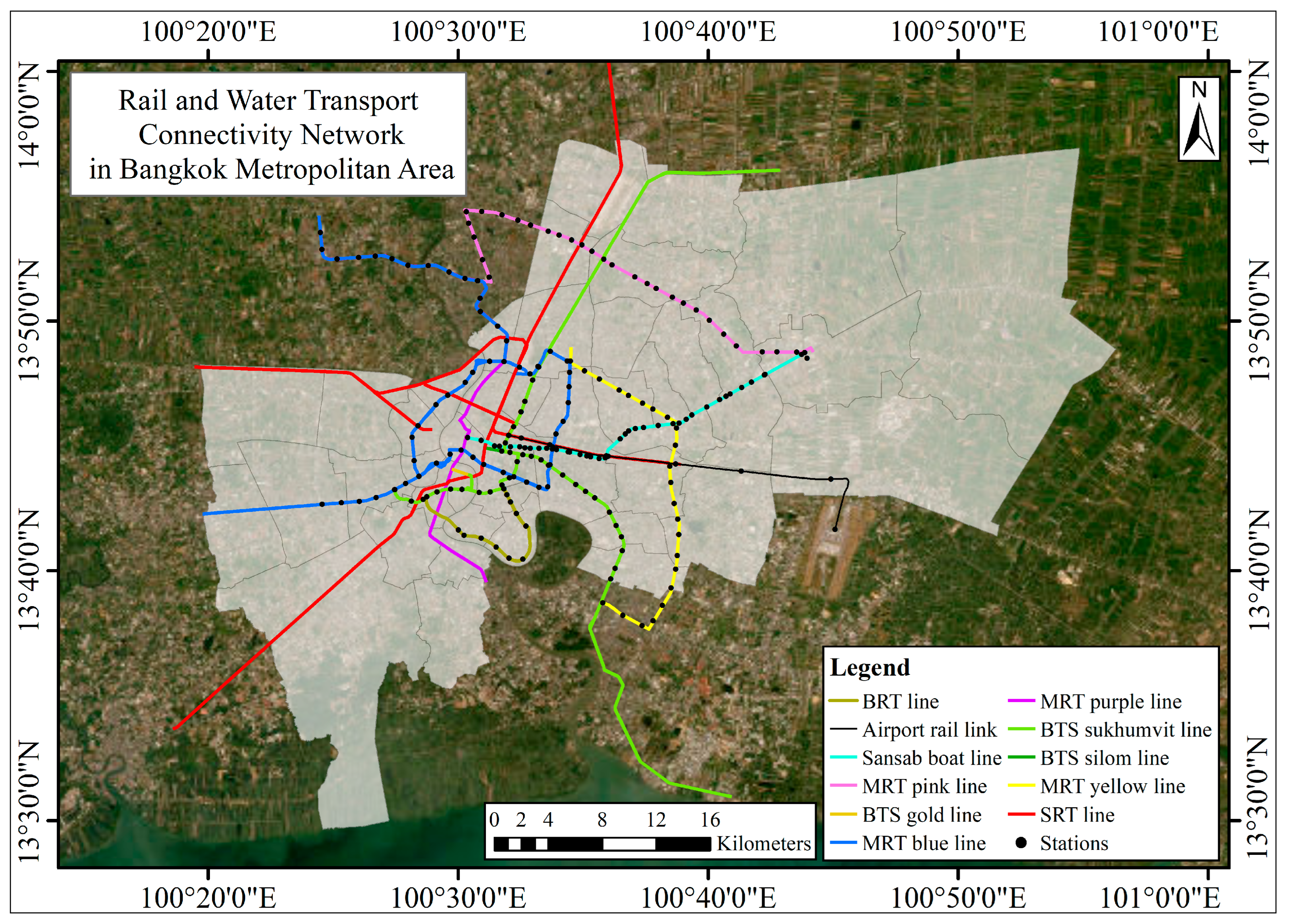



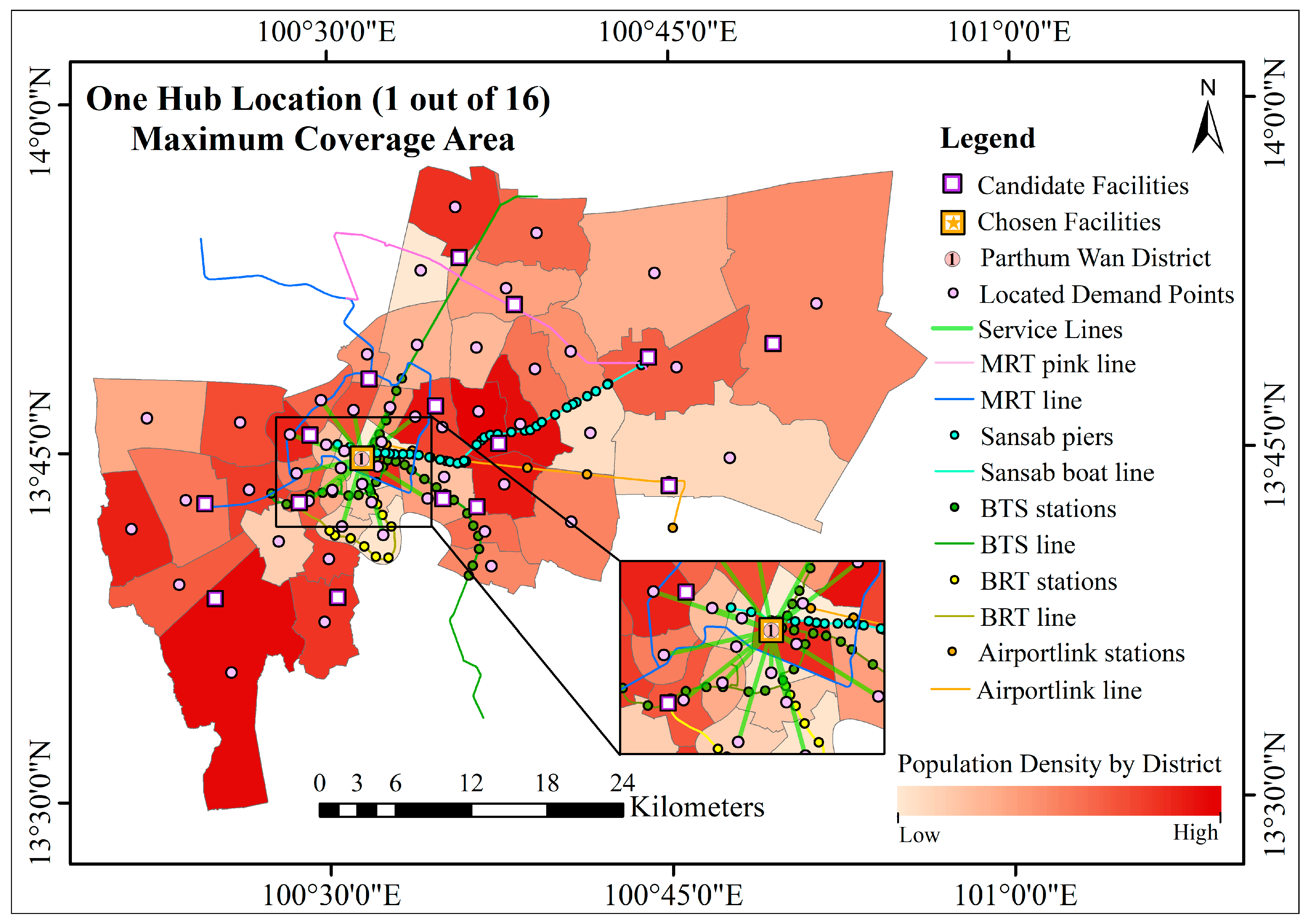
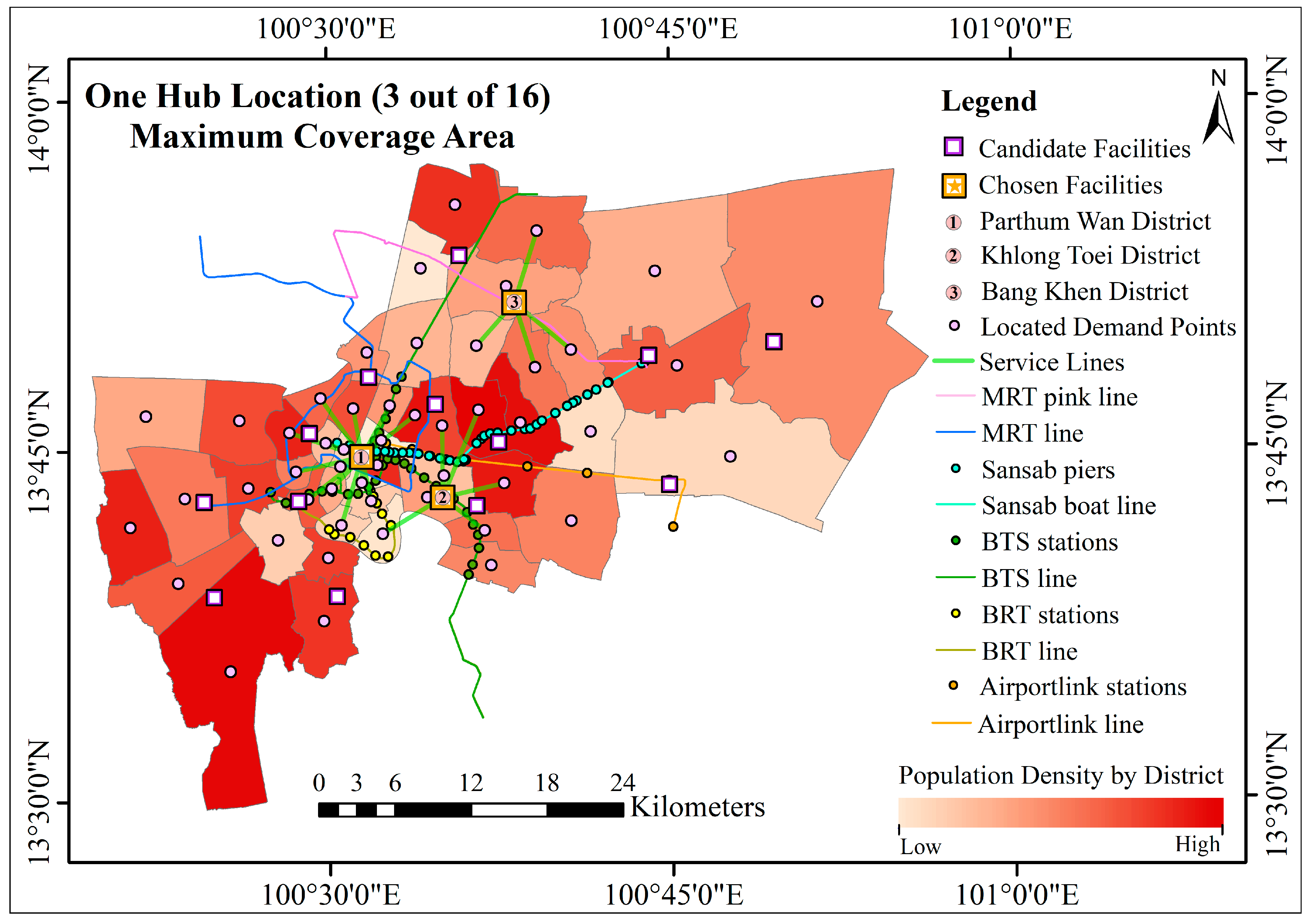



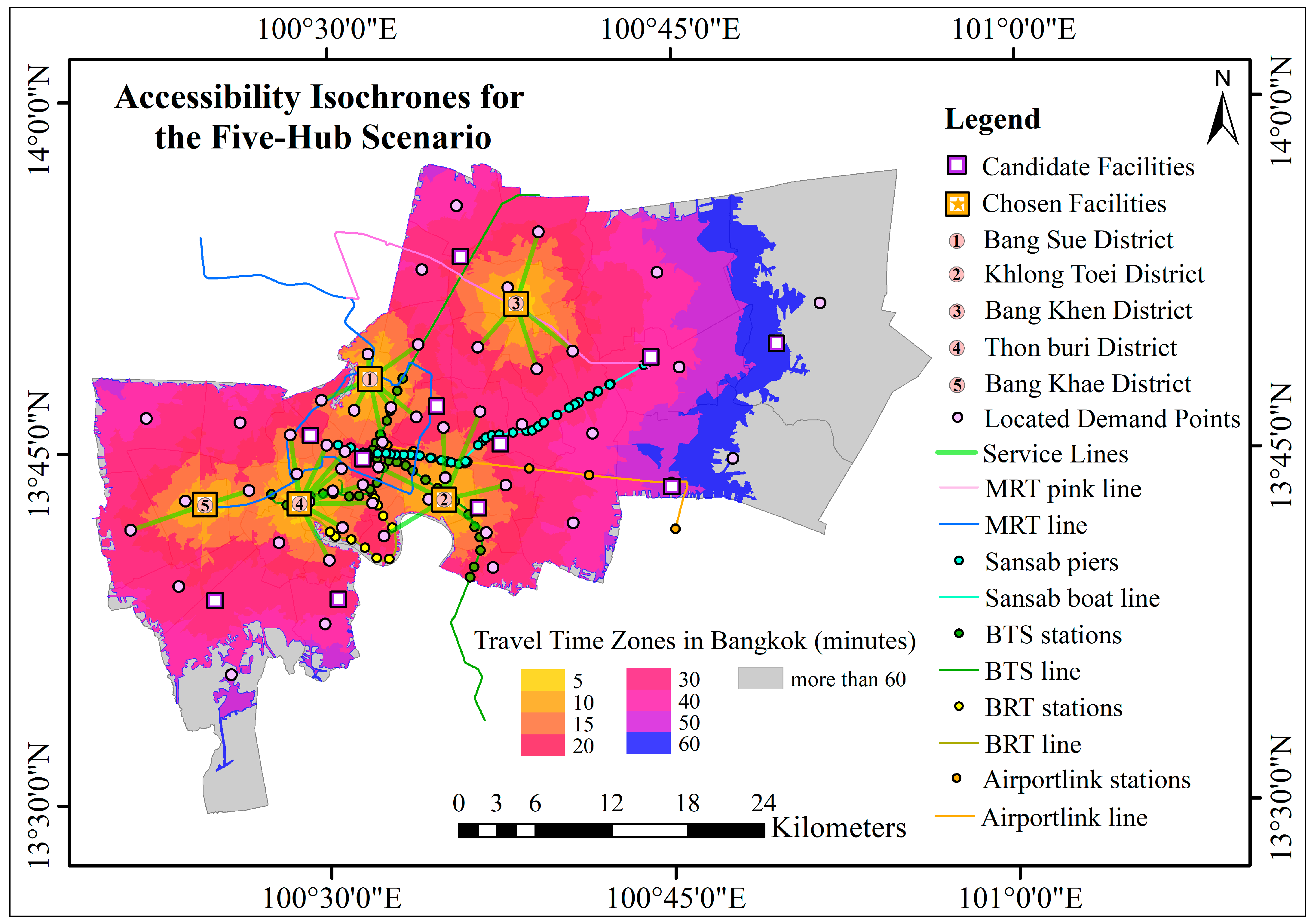
Disclaimer/Publisher’s Note: The statements, opinions and data contained in all publications are solely those of the individual author(s) and contributor(s) and not of MDPI and/or the editor(s). MDPI and/or the editor(s) disclaim responsibility for any injury to people or property resulting from any ideas, methods, instructions or products referred to in the content. |
© 2025 by the authors. Licensee MDPI, Basel, Switzerland. This article is an open access article distributed under the terms and conditions of the Creative Commons Attribution (CC BY) license (https://creativecommons.org/licenses/by/4.0/).
Share and Cite
Boonprong, S.; Varnnakovida, P.; Rinrat, N.; Kaytakhob, N.; Kitsamai, A. Geo-Spatial Optimization and First and Last Mile Accessibility for Sustainable Urban Mobility in Bangkok, Thailand. Sustainability 2025, 17, 9653. https://doi.org/10.3390/su17219653
Boonprong S, Varnnakovida P, Rinrat N, Kaytakhob N, Kitsamai A. Geo-Spatial Optimization and First and Last Mile Accessibility for Sustainable Urban Mobility in Bangkok, Thailand. Sustainability. 2025; 17(21):9653. https://doi.org/10.3390/su17219653
Chicago/Turabian StyleBoonprong, Sornkitja, Pariwate Varnnakovida, Nawin Rinrat, Napatsorn Kaytakhob, and Arinnat Kitsamai. 2025. "Geo-Spatial Optimization and First and Last Mile Accessibility for Sustainable Urban Mobility in Bangkok, Thailand" Sustainability 17, no. 21: 9653. https://doi.org/10.3390/su17219653
APA StyleBoonprong, S., Varnnakovida, P., Rinrat, N., Kaytakhob, N., & Kitsamai, A. (2025). Geo-Spatial Optimization and First and Last Mile Accessibility for Sustainable Urban Mobility in Bangkok, Thailand. Sustainability, 17(21), 9653. https://doi.org/10.3390/su17219653







